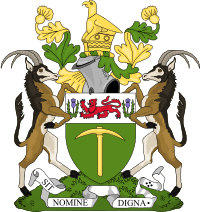Southern Rhodesian constitutional referendum, 1961
 |
| This article is part of a series on the politics and government of Rhodesia |
|
Constitutional history
|
|
Government |
|
Legislature
|
|
Foreign relations |
|
National symbols |
A constitutional referendum was held in Southern Rhodesia, then a constituent territory of the Federation of Rhodesia and Nyasaland, on 26 July 1961. The new constitution was approved by about 66% of those who voted; turnout was 77%. Registered voters at the time were mostly white because of the qualified franchise, under which only those who met certain financial, educational and property standards were eligible to vote.[1]
Background
Following three years of negotiations with the Southern Rhodesian government and other parties, the British government had put forward a draft constitution on 13 June 1961. It provided for a parliamentary system, with a 65-seat parliament;[2] the previously common voters' roll was divided into two rolls, the "A" roll and the "B" roll, the latter of which had lower qualifications intended to make it easier for prospective voters to enter the political system. There were 50 "A"-roll constituencies and 15 larger "B"-roll districts, with a complicated mechanism of "cross-voting" allowing "B"-roll voters to slightly influence "A"-roll elections and vice versa. This system was theoretically non-racial, but in practice the "A" roll was largely white and the "B" roll was almost all black.[3]
Results
| Choice | Votes | % |
|---|---|---|
| For | 42,004 | 65.79 |
| Against | 21,846 | 34.21 |
| Invalid/blank votes | 552 | – |
| Total | 64,402 | 100 |
| Registered voters/turnout | 83,486 | 77.14 |
| Source: Wood[1] | ||
Unofficial National Democratic Party referendum
In protest against the official referendum, the black nationalist National Democratic Party (NDP) ran its own poll, professedly based on "one man, one vote", on 23 July. This was peacefully operated, but reportedly amateur and potentially biased in its execution, garnering criticism from British officials, rival nationalists and other observers amidst its virtually unanimous rejection of the constitution. The British High Commission commented that voters in the NDP referendum appeared to be subject to intimidation by the NDP officials running the exercise, and that the votes did not seem to be secret. The rival Zimbabwe National Party called the NDP poll "phoney" and said it was designed "to hoodwink the African people".[4] There were many cases of people posting multiple ballots: two whites told the press they had voted twice and one black man proudly announced that he had done so 11 times.[4] After the government released the results of the official referendum, the NDP announced that their poll had garnered 467,189 votes against the constitution, and only 584 in favour—a reported majority of about 99.9% against.[4] According to historian J. R. T. Wood, the NDP referendum "smacked of farce";[4] he highlights the fact that the general strike of black workers called by the NDP for the next day was adhered to by less than 10% of the black workforce.[4]
Results
| Choice | Votes | % |
|---|---|---|
| For | 584 | 0.12 |
| Against | 467,189 | 99.88 |
| Total | 467,773 | 100 |
| Source: Wood[4] | ||
References
- 1 2 Wood, J. R. T. (June 2005). So far and no further! Rhodesia's bid for independence during the retreat from empire 1959–1965. Victoria, British Columbia: Trafford Publishing. p. 92. ISBN 978-1-4120-4952-8.
- ↑ Blake, Robert (1977). A History of Rhodesia. New York: Alfred A. Knopf. p. 335. ISBN 0-394-48068-6.
- ↑ Palley, Claire (1966). The Constitutional History and Law of Southern Rhodesia 1888–1965, with Special Reference to Imperial Control (First ed.). Oxford: Clarendon Press. pp. 414–416. OCLC 406157.
- 1 2 3 4 5 6 Wood 2005, p. 90